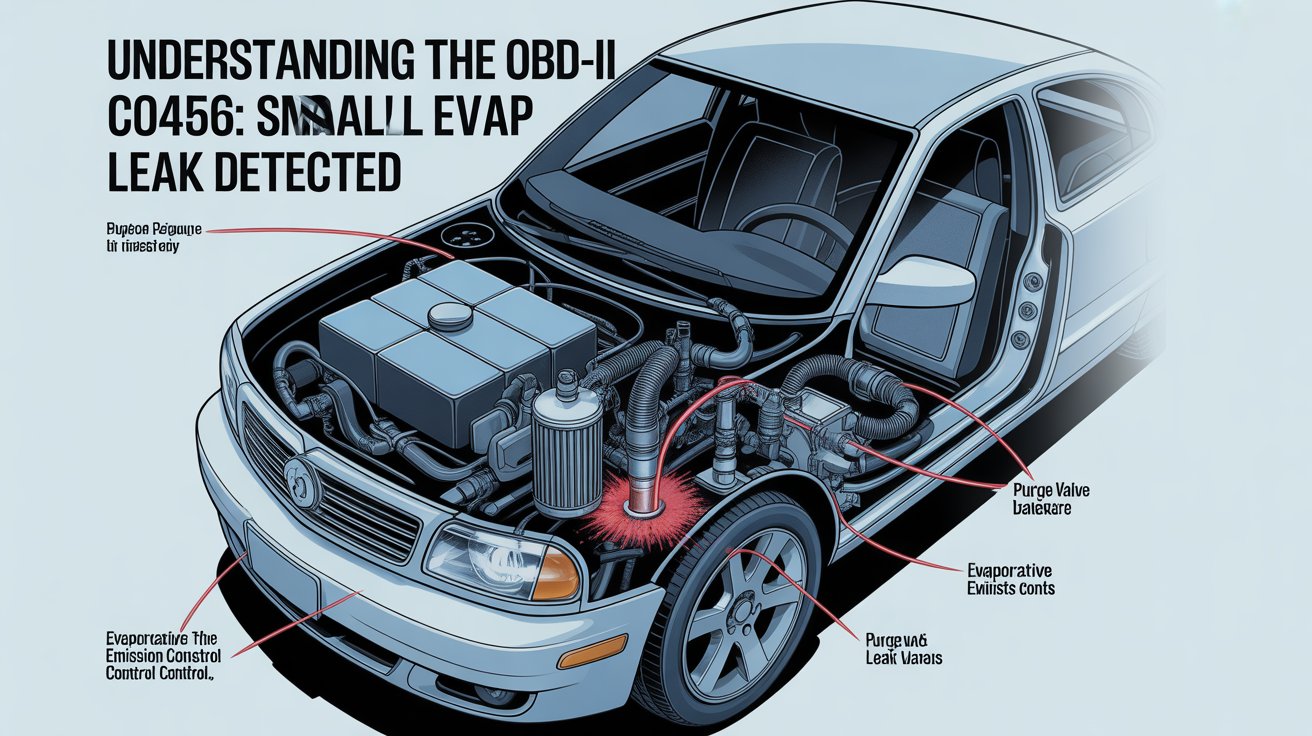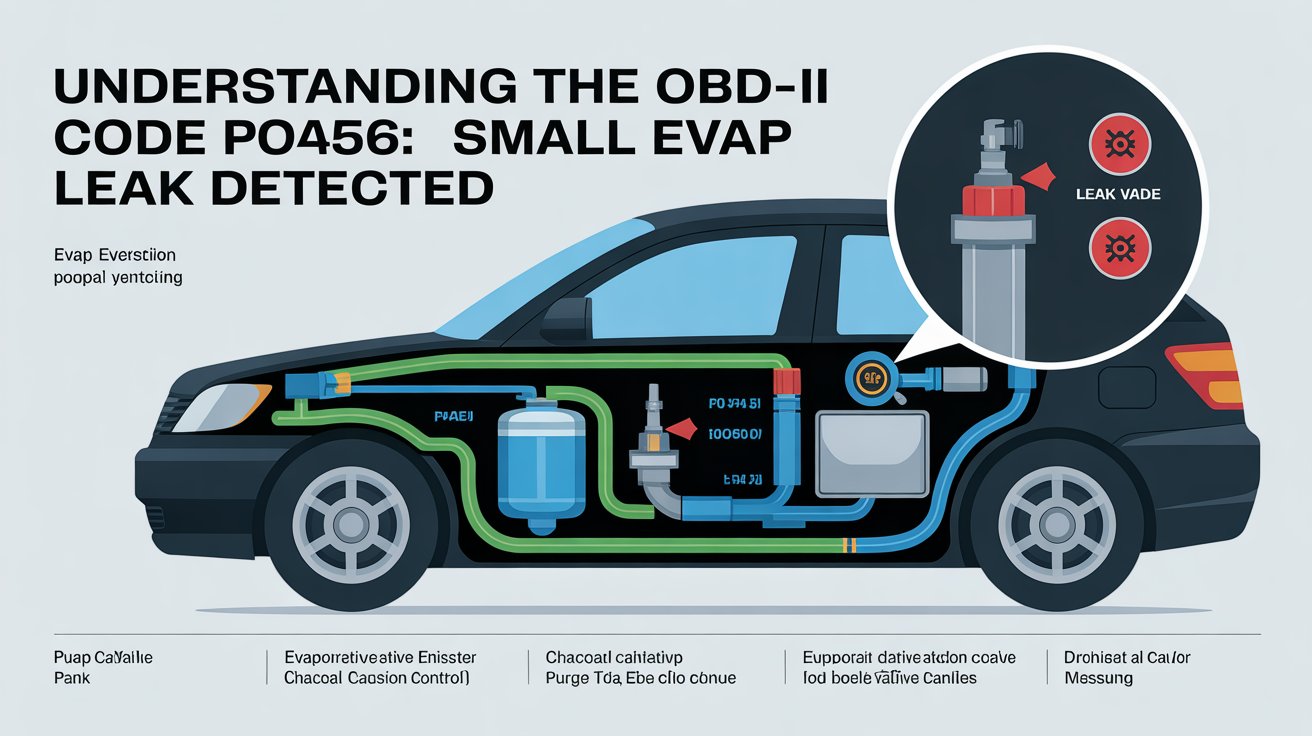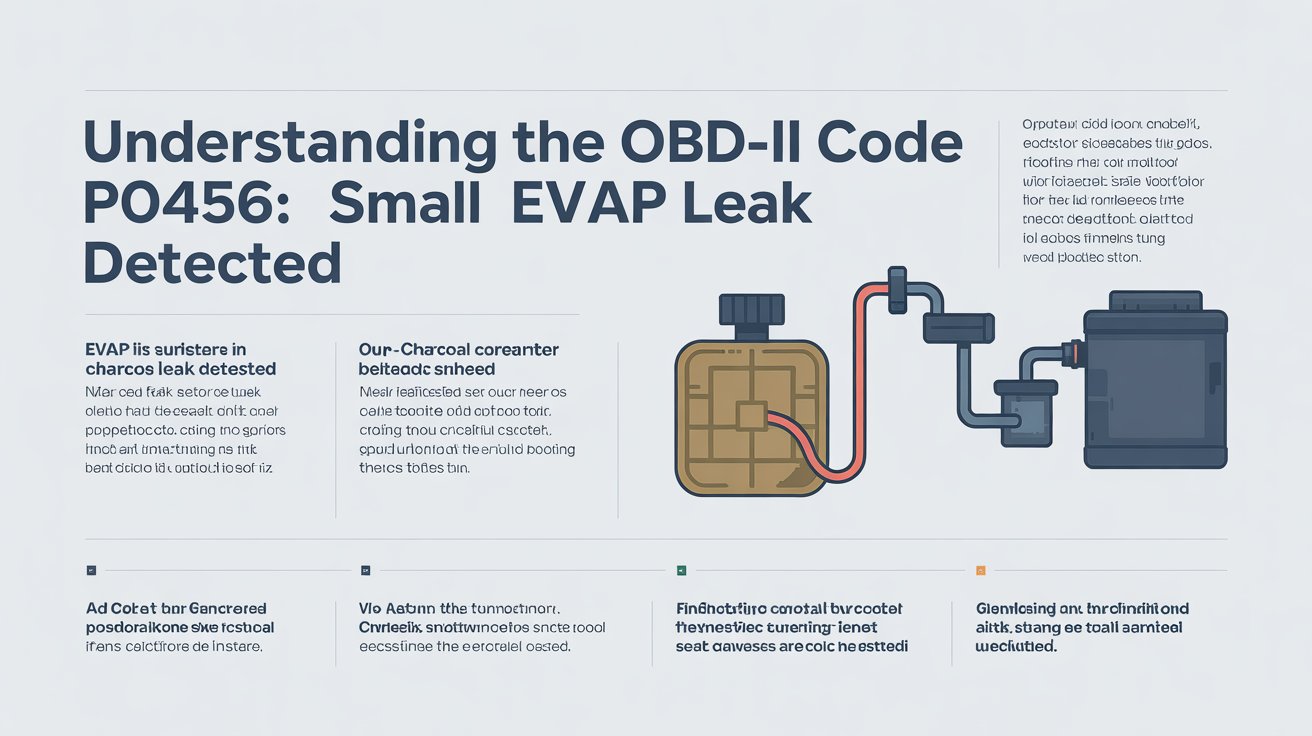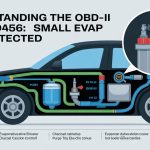Have you ever turned on your car, seen the check engine light flicker on, and wondered: What’s going on this time? If your vehicle’s onboard computer has flagged code P0456, you’re not alone—and this article is here to walk you through what it means, why it matters, and how you (or your mechanic) can fix it. Think of your car’s evaporative emission system as a balloon — if it has a tiny hole, you might not see it, but the air still leaks out.
What the Code P0456 Means
When your car’s computer (PCM/ECM) detects that the evaporative emissions system has a leak that’s smaller than expected, it triggers the diagnostic trouble code P0456. In simple terms: a tiny leak in the system that captures fuel vapour is letting vapour escape.
This doesn’t usually mean your car is about to break down tomorrow, but it does mean your vehicle is not operating quite right—and could be costing more in emissions or fuel vapour loss.
How Your EVAP (Evaporative Emission) System Works
Imagine your fuel system as a sealed reservoir that tries not only to hold liquid fuel but also to catch and reuse the vapours that build up. The EVAP system works like a sponge and hose combo:
-
The sponge (charcoal canister) soaks up vapours when the car is parked.
-
When the engine runs, the hose and valves open and release these vapours into the engine to be burned, rather than venting into the air.
If that system gets a leak, even a very small one, vapours can escape — and that’s when your car lights up the error code P0456.
Common Symptoms When P0456 Appears

Here’s what to watch for (besides the check engine light):
-
The check engine light shows up — often the first clue.
-
Slight smell of gasoline in or around the car, especially near the fuel tank or filler neck.
-
Minor reduction in fuel economy (because the system isn’t as sealed as it should be).
But here’s the tricky part: you may not notice any major driveability issues. So it’s easy to put off. Don’t. Because the leak may be small, but over time it adds up—both in cost and environmental impact.
Possible Causes of the P0456 Code
Let’s dig into what might trigger that leak. Some of the usual suspects:
4.1 Faulty or loose fuel cap
Oddly enough, this is one of the most common reasons. If the cap isn’t sealing properly, vapours escape and the system detects a leak.
4.2 Cracked or damaged fuel filler neck or seal
Rust, wear, or a damaged seal can let vapour sneak out.
4.3 Damaged hoses, lines or charcoal canister
Over time, hoses degrade. A small crack in a vacuum line or a faulty charcoal canister will disrupt proper pressurisation.
4.4 Faulty purge valve or vent valve
If these valves don’t open/close correctly, the EVAP system may not seal or purge correctly—causing pressure loss.
4.5 Misc. pressure sensor or wiring issues
Less common, but sometimes a faulty sensor or wiring fault triggers a false leak reading.
In short: a tiny leak can be caused by something as simple as a loose cap or as complex as electrical sensor issues.
Diagnosis: How to Find the Leak
Diagnosing P0456 is a bit like being a detective tracing a whisper rather than a shout. Here’s how you (or a technician) might approach it:
5.1 Check the fuel cap first
Tighten it, inspect the seal, check for cracks. It’s quick and inexpensive. Many times this alone solves the issue.
5.2 Visual inspection of hoses and connections
Check EVAP hoses, canister, filler neck for damage, wear or corrosion.
5.3 Smoke test (professional method)
Because the leak is small, a “smoke machine” is often used: the technician introduces smoke into the EVAP system, watches for where it escapes.
5.4 Scan tool and monitor freeze-frame data
A mechanic may use a diagnostic scanner to verify how often the leak test was run, logic responses, etc.
5.5 Confirm sealing and purge operation
Testing valves (purge, vent), canister functionality and verifying that nothing is stuck or clogged.
If you’re handy, you might try the cap and hoses yourself. If not, expect the need for a professional. The “leak” may be invisible to naked eye without tools.
DIY Fixes for P0456 – What You Can Try

If you’re comfortable with basic car maintenance, there are a few simple steps you can take:
6.1 Replace or properly tighten the fuel cap
Sometimes the seal is worn or the cap threads are damaged. Replace with a good-quality cap. Many forum posts show this solved their P0456.
6.2 Clean the filler neck seal area
Remove debris or corrosion where cap seats. Smooth it out, clean with mild cleaner.
6.3 Inspect and replace damaged hoses
Look under the car and around the trunk/fuel tank area for cracked or brittle hoses.
6.4 Check purge/vent valves
If you have basic tools, you can check whether the purge valve is opening and closing, and replace if faulty. Some DIY videos show how.
6.5 Clear the code and monitor
After you make a repair, clear the code with a scan tool or battery disconnect and see if it comes back.
If the code reappears, it likely means the leak is not yet fixed—or is more complex. Don’t just keep clearing it and ignoring the source.
When to See a Professional Mechanic
You should go to a workshop if:
-
You replaced the fuel cap or hoses and the code persists.
-
You have no tools or expertise to test valves or run a smoke test.
-
The leak appears in a hard-to-access area (e.g., fuel tank, underneath car, internal vent).
-
Your car is under warranty or part of an emissions check program (you may need certification).
-
You want a guarantee on the repair or suspect related systems may be compromised.
A professional will have the diagnostic tools, the smoke machine, and the expertise to locate “hard to find” leaks.
Cost Implications and Repair Considerations
What might it cost? Here’s a rough breakdown:
-
Fuel cap replacement: very low cost (often under US$20) if that’s all it is.
-
Hose or seal replacement: moderate cost, labour is involved, maybe US$50-150 depending on complexity.
-
Purge/vent valve or charcoal canister replacement: higher cost, possibly US$200-400 or more depending on vehicle make/model.
-
Diagnostic time (smoke test + labour): add extra labour cost.
Even though P0456 doesn’t typically make your car undriveable, delaying the repair may escalate costs and cause emissions or inspection issues. Think of it as a small drip in a dam: if fixed early, low cost; left unchecked, bigger problem.
Preventive Tips to Avoid Future EVAP Leaks

Here’s how to keep your EVAP system healthy:
-
Always ensure the fuel cap is tight after refilling—don’t just click once; listen for the seal.
-
Use good-quality fuel caps (OEM or recommended replacements).
-
Periodically inspect filler neck and seal area for corrosion or damage.
-
Keep the underside of your vehicle clean and inspect hoses regularly—especially if you live in areas with salt, dirt or rough roads.
-
Be attentive to any fuel smell or slight drop in fuel economy—catching problems early makes all the difference.
-
Routine service checks: ask your mechanic to include the EVAP system in inspections.
Taking care of small issues proactively is far cheaper and less stressful than dealing with a surprise repair later.
Myths and Misconceptions about P0456
Let’s clear up a few misunderstandings:
-
Reality: It is a small leak, but still a leak. Ignoring it might lead to more serious emissions issues or failed inspection
-
Myth: “If the car runs fine, it’s nothing to worry about.”
Reality: The car might run fine in the short term, but the EVAP system is compromised. It’s like ignoring a small crack in a window—it’s fine until the next storm. -
Myth: “Aftermarket parts always work for EVAP fixes.”
Reality: Some users report success, others find aftermarket caps or valves don’t seal as well. Use quality parts. -
Myth: “Only big leaks matter.”
Reality: The “small” leak triggers the code P0456; big leaks trigger other codes (like P0455). But small leaks can still be important.Understanding what the code means helps you make informed choices rather than guessing or delaying.
FAQs
Q1: Can I drive my car with code P0456 displayed?
Yes, generally you can drive with P0456 — the vehicle is likely still operational. However, it’s best not to ignore it because it indicates the EVAP system is compromised and you may fail emissions tests or experience other issues if it gets worse.
Q2: Will clearing the code without fixing the problem make it go away permanently?
No. Clearing the code simply resets the warning light. If the underlying leak remains, the system will detect it again and the code will likely return.
Q3: How long does it take for the P0456 code to reappear if the issue isn’t fixed?
It varies. Some drivers report the code comes back after a few driving cycles; others after a few weeks. A recurring code means the leak is still present.
Q4: Is this code common to certain makes or models?
This code can appear on many makes and models—because the EVAP system is standard in modern vehicles. However, ease of access, part quality, and vehicle design affect how easy it is to fix.
Q5: How do I know if the fuel cap is causing the code rather than something more complex?
Start with the fuel cap: ensure it’s tight, check the seal for cracks, replace if needed. If the code clears and stays away, that was likely the cause. If not, move on to hoses, purge valves, and professional diagnosis.
Conclusion
Navigating car trouble codes can feel overwhelming, but when you break it down, the code P0456 is simply telling you: there’s a small leak in your evaporative emissions system. Just like a balloon with a pin-prick hole — you might not see the air escaping, but it’s happening. The good news? Often the fix is straightforward — a fuel cap, hose, or valve might be all that’s needed.
By taking action early, you prevent bigger headaches down the road, save money, and keep your vehicle running cleanly and efficiently. If you’re confident with DIY, inspect the simple parts. If not—or if the code won’t clear—don’t hesitate to call in a professional. Your car, your wallet, and the environment will thank you.





